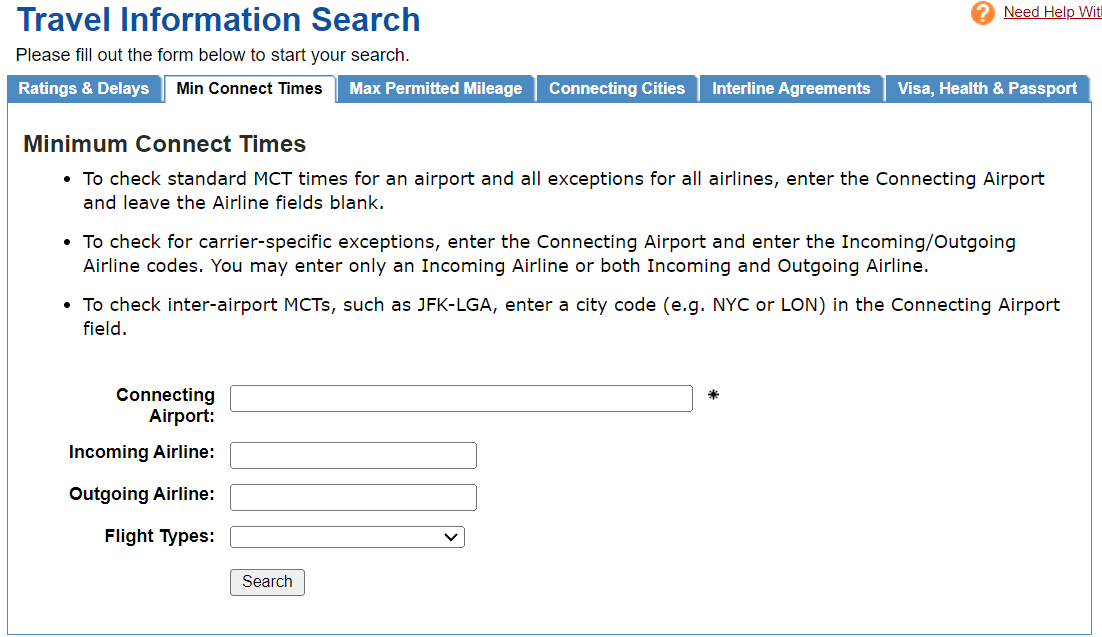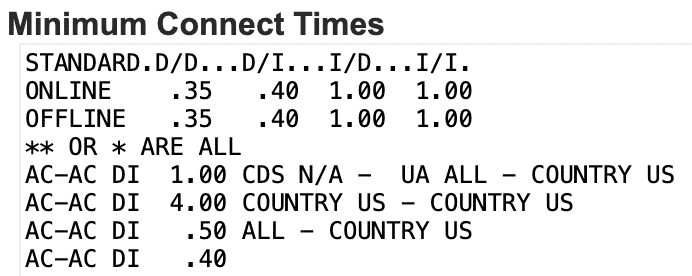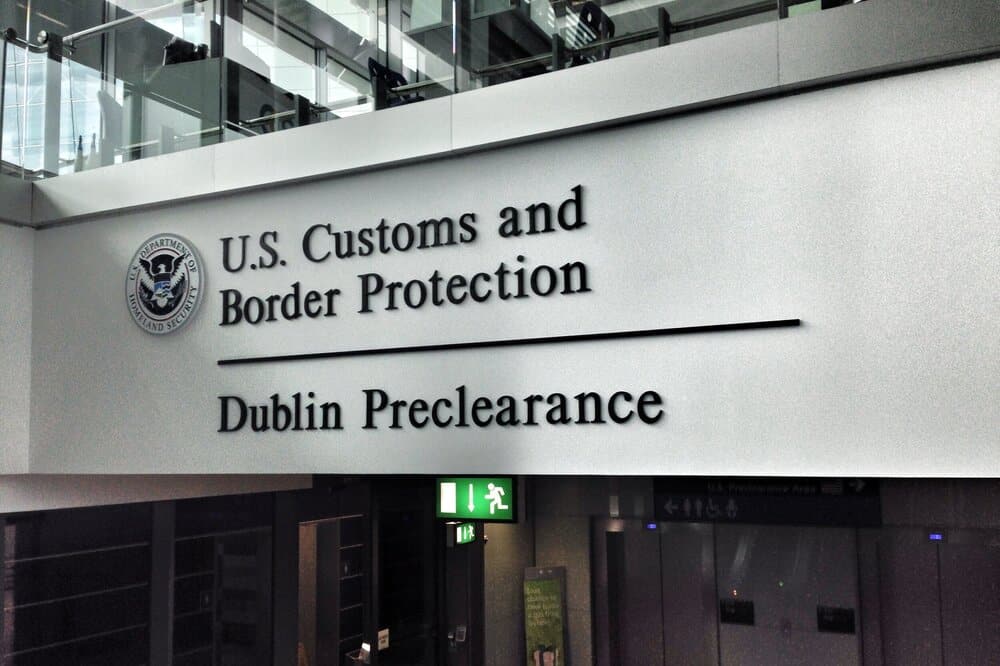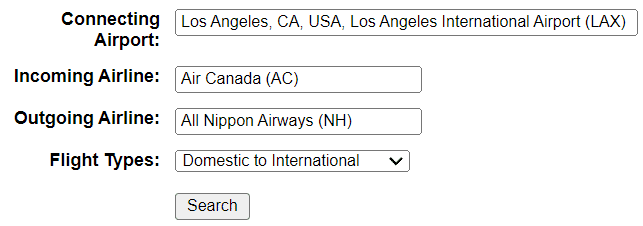When piecing together a custom itinerary, it’s sometimes the case that you’ve found the perfect flights, only for an agent to let you know that it’s not a valid itinerary.
One of the reasons why that may be so is that your flights didn’t respect the minimum connection time (MCT) for one or more of the airports in your itinerary.
Minimum connection times are one of the many factors that you need to consider when planning out a trip. While they may limit your options in some situations, you can also benefit from schedule changes on tight connections.
Let’s take a look at minimum connection times, why they’re important, how to find out what a minimum connection time is, and how you can stand to benefit from schedule changes.
In This Post
What Are Minimum Connection Times?
Every airport around the world has a set of rules for how much time is needed to transit through that airport on the same ticket. It’s basically a measure of how easily navigable the airport is for connecting passengers.
If it’s a tiny facility with just a few gates, the minimum connection time will be very low. On the other hand, more expansive airport facilities around the world with multiple terminals and concourses will have minimum connection times verging on two hours or more.
Airlines must follow these MCTs when issuing a ticket, and they’re usually pretty strict about these rules. Airlines can face penalties if passengers end up missing a flight because a connection was booked under the minimum time.

Whenever you search for flights, be it a cash booking or one with points, all the one-stop, two-stop, or three-stop itineraries that are presented to you will have already factored in the minimum connection time, and you won’t see any options that run afoul of this rule.
It’s only when you’re piecing together an award itinerary that’s more complex than what the search engine spits out that you’ll need to be mindful of the minimum connection time at the airport you’re planning to transit through.
This is particularly relevant if you’re using a program like Aeroplan, and you’re piecing together a complex itinerary that can’t be booked online.
Here are a few examples of minimum connection times at some airports around the world that you might find yourself looking at:
-
Toronto (YYZ): 40 minutes (Domestic–Domestic), 1 hour (Domestic–International and International–International), 1 hour 15 minutes (International–Domestic)
-
Montreal (YUL): 30 minutes (Domestic–Domestic), 1 hour (all other flights)
-
Vancouver (YVR): 40 minutes (Domestic–Domestic), 1 hour (Domestic–International and International–International), 1 hour 20 minutes (International–Domestic),
-
Newark (EWR): 1 hour (Domestic–Domestic or International–International), 1 hour 15 minutes (Domestic–International), 1 hour 30 minutes (International–Domestic)
-
San Francisco (SFO): 50 minutes (Domestic–Domestic), 1 hour (Domestic–International), 1 hour 45 minutes (International–Domestic or International–International)
-
Frankfurt (FRA): 45 minutes
-
Zurich (ZRH): 40 minutes
-
Istanbul (IST): 30 minutes (Domestic–Domestic), 1 hour 15 minutes (Domestic–International or International–International), 1 hour 30 minutes (International–Domestic)
-
Singapore (SIN): 30 minutes (Domestic–Domestic), 1 hour (Domestic–International), 1 hour 30 minutes (International–Domestic and International–International)
-
Beijing (PEK): 1 hour 30 minutes
-
Tokyo (HND): 30 minutes (Domestic–Domestic), 1 hour 40 minutes (International–International), 2 hours (Domestic–International, International–Domestic)
-
Tokyo (NRT): 30 minutes (Domestic–Domestic), 1 hour (Domestic–International), 1 hour 30 minutes (International–Domestic and International–International)
-
Dubai (DXB): 20 minutes (Domestic–Domestic), 1 hour (Domestic–International or International–Domestic), 1 hour 15 minutes (International–International)
-
Cairo (CAI): 30 minutes (Domestic–Domestic), 1 hour 30 minutes (all other flights)
-
Addis Ababa (ADD): 30 minutes (Domestic–Domestic), 45 minutes (International–International), 1 hour (Domestic–International or International–Domestic)
-
São Paulo (GRU): 1 hour (all flights except International–Domestic), 1 hour 30 minutes (International–Domestic)
-
Panama City (PTY): 30 minutes (Domestic–Domestic), 1 hour (Domestic–International or International–Domestic), 1 hour 30 minutes (International–International)
You’ll notice that the MCTs mostly account for how long it would take to make your way from one gate to another, factoring in any obstacles that the passenger must traverse along the way.
For example, Zurich Airport is well-known for being very easy to transit through, with automatic people movers providing seamless connections between the various concourses. When an airport is easy to navigate like in Zurich, the minimum connection time is only 40 minutes.

On the other hand, Tokyo Haneda has separate terminals for domestic and international flights, so Domestic–Domestic connections are very quick at only 30 minutes.
But if you’re connecting from a domestic flight onto an international flight, or vice versa, you’ll require at least two hours to factor in the journey on the inter-terminal monorail.
How to Find the Minimum Connection Time
Looking up the minimum connection time is one of the many useful capabilities of ExpertFlyer. If you aren’t currently an ExpertFlyer subscriber, you can use the five-day free trial to look it up, as well.

You’ll want to look under the Travel Information section, followed by the “Min Connect Times” tab. You’ll be prompted to enter the Connecting Airport in question, as well as the Inbound and Outbound Airlines, and the “Flight Type” you’re looking up (i.e., some combination of domestic and international flights).

The first few lines of the results show you the “standard” minimum connection times of that airport. The four standard times correspond to connections of the Domestic–Domestic, Domestic–International, International–Domestic, and International–International variety, respectively.
There are also separate lines for “Online” and “Offline”, which refer to connections between the same airline and different airlines. There usually isn’t any difference between the times listed on these two lines.
In the above example, we can see that the MCT in Calgary for a Domestic–Domestic flights is 35 minutes, and a Domestic–International flight is 40 minutes. For International–Domestic or International–International flights, the MCT is 1 hour.
The remaining lines detail all the exceptions to the rule, which tend to be quite numerous for any major airport.
The world of airline jargon can get convoluted very quickly, so don’t be surprised if you see some things that don’t make sense. Rather, the most important MCTs to pay attention to are at the top of the results in the “Online” and “Offline” rows.
Minimum Connection Times & US Pre-Clearance
One thing to note is that if you’re flying into the US from an airport that has a US pre-clearance facility, such as most major airports in Canada, as well as Dublin and Abu Dhabi, then the flight is treated as a domestic flight for the purposes of minimum connection times.
After all, you’ve already technically “entered” the US at your point of departure, and upon deplaning in the US, you’ll find yourself in the domestic terminal with all the other domestic US flights.

So if you’re looking at US gateway airports for a flight from Montreal down to Newark and then onwards to Europe, or Vancouver down to Los Angeles before flying to Asia, you’d be looking at the “D–I” minimum connection time for Newark or Los Angeles, rather than “I–I”.
This is important to keep in mind, since it can be the difference between being forced into an overnight hotel stay and booking a tight but valid connection at the US gateway airport.


In the above example, you could take a connection of 1 hour 30 minutes to get from an inbound Air Canada flight from Vancouver to an outbound flight with All Nippon Airways to Tokyo. But if you were coming in from another country without a pre-clearance facility, you’d be subject to a 2 hour MCT.
The opposite, however, is not true: if you’re connecting through the US on your way to Canada, that’s still treated as an international flight and you’ll still be looking at the “I–I” minimum connection time.
Can Minimum Connection Times Be Overridden?
You may be wondering if you can simply volunteer to risk a tight connection.
For example, there may be instances when you’d be within a few minutes of legally making a connection to the last flight back home for the night.
If you don’t make the flight, you’d either have to take an unpleasant red-eye flight or an overnight layover at the connection point.
Or, there might be a situation in which only one flight for a desired routing is available for the whole day, but it falls afoul of the minimum connection time from a previous flight.
Since waiting for the next available flight would result in a connection of over 24 hours, it would then become it an invalid layover and subject to stopover pricing.

Even if you try to present your case to the agent and ask them to make an exception, you’ll likely be met with steadfast refusal every time.
The agents will emphasize that the computer system won’t let them book the connection, and that the minimum connection time is very much a hard and fast rule.
Even if they were to somehow override it, the airline and/or loyalty program would be subject to penalties if you were to indeed misconnect along your journey, as a result of them having booked you on an illegal connection.
Remember, if you’re booked on connecting flights on the same ticket and miss your connection as a result of a delay, the operating airline is obligated to rebook you on a different flight to get you to the destination.
However, in theory, if you were booked on a connection tighter than the minimum connection time, then you could misconnect even if your inbound flight isn’t delayed, and no airline wants to put themselves in that position.
Of course, you can also use minimum connection times to your advantage in the event of schedule changes.
If you’ve booked a connection that’s right against the minimum, and a 10-minute schedule change results in your connection now being deemed illegal, you can call up the frequent flyer program you used and make a change to your itinerary without paying any change fees as a result.
Conclusion
Minimum connection times are one of those minute details in the travel and aviation world that you’ll usually only need to deal with if you’re piecing together complex, customized trips.
They provide guidance as to how tight of a connection you’re allowed to book on a single itinerary. You you can easily look them up using ExpertFlyer the next time you’re planning a trip to check whether your connection is legal.
In addition, the fact that airlines are such sticklers for the minimum connection time can be used to score some easy change fee waivers as well.




















I just had an itinerary canceled – the Aeroplan agent booked it for me, 5 mins later I got an email saying it was canceled. Called back and the new agent took 90 minutes to figure out why – my 5 hour connection time in Sao Paulo between GRU and CGH (the local airport 60 minutes away) was considered illegal. Even the 7 hour connection was also denied in my award ticket. I ended up cancelling that leg and will buy out of pocket a better flight out of GRU (with Latam, which is not an Aeroplan partner) for 70 CAD and avoid the whole debacle. Frustrating though, especially the time wasted on the phone! Nobody could confirm what the actual MCT was in this case.
I’m curious whether anyone knows how much connection time we may need with our yyz to yvr to hnl (in Aug and with covid)? The flights offered by WJ has yvr to hnl options a 1hr10mins, 2hr10 mins or 4hr10 mins? Our outbound leaves from yyz so hoping our covid tests and pre security checks will be done upfront. But we are also hearing that many flights are being delayed so want to ensure enough but not too long connection times. Thanks so much ahead of time.
If WestJet is offering the flight, then it’s considered a “safe” connection by the airline and they will rebook you on the next flight if you happen to misconnect due to the inbound flight being late. However, I’d personally pick the 2h10m option for added comfort and peace of mind in your situation.
A few days ago, I had a 30 minute connection time in Vienna when flying ZAG-VIE-ZRH-LHR (and onward from there). I was surprised that I was allowed to book that, as I had to go through security and immigration and then sprint to my gate. Surely enough, I missed the connection and went to see an Austrian Airlines representative, who rebooked me on the next VIE-LHR direct flight in J. It was a nice surprise to see that it was coded as a paid business fare, and I had a decent deposit of Aeroplan miles as a result of the change. Also, my bag arrived in Toronto two days before I did!
I just love how you find answers to the different questions that hunt us while booking a flight Ricky.
About connecting time: I’ll be flying into TPE from BKK on BR, and flying out to YVR with AC. connecting time I-I is 1h, and I have 1h15 min. So I should be OK, especially since it’s same terminal 2.
However, in the notes below I saw the following line: BR-** II 1.30 TRM 2 – 2
Does it mean if I’m arriving on BR into Terminal 2 I’ll need 1:30 independently of my departure airline?
Looks like it. Did you manage to book the 1h15m though? I’m not sure how consistently the notes below the standard MCTs are enforced.
Yes, the booking was done back in March. If I miss the AC flight TPE-YVR, should I call AP so they can rebook us or AC at TPE should take care of that?
This past spring, was on a mini-RTW, SGN-KIX on Asiana. I had a 45min connection at ICN!!! Needless to say, we departed late from SGN and missed the connection at ICN. Asiana gave myself and my wife 90,000 Korean Won, 6 hours in the transit hotel, and rebooked us on Korean Air in business (same fare case as our award tickets). I was very impressed!
I recently flew AMM-IST-ATL-YYZ where the connection time at Atlanta was 50 minutes, but I wanted the last AC flight out of ATL instead of overnighting. The first AP agent refused to book it, the second one did it no questions asked! Ended up making my flight with tons of time to spare since Turkish blocks way more time than the actual flight length.
Awesome data point. I’ve personally looked at the IST-ATL-YYZ connection multiple times and have been frustrated that it was under the MCT, so it’s great to know that it’s in fact bookable!
Timely article! I was wondering about an aeroplan booking I made. Going from HK to YVR with only 1 hour connection. They allowed it so I assume it’s legit?
If they allowed it, you’re good. But it doesn’t necessarily mean that it’ll be a comfortable connection or that you won’t feel rushed about it. Remember that they’re obligated to rebook you if you misconnect as a result of any delay though.